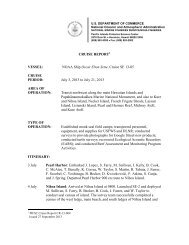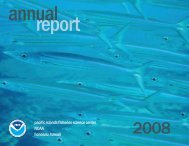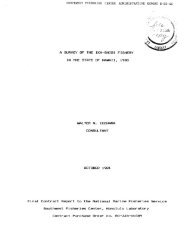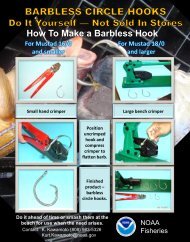Contingency Plan for Hawaiian Monk Seal Unusual Mortality Events
Contingency Plan for Hawaiian Monk Seal Unusual Mortality Events
Contingency Plan for Hawaiian Monk Seal Unusual Mortality Events
You also want an ePaper? Increase the reach of your titles
YUMPU automatically turns print PDFs into web optimized ePapers that Google loves.
A-1<br />
Introduction<br />
HAWAIIAN MONK SEAL SPECIMEN COLLECTION PROTOCOL<br />
Jan 29 2003/RCB<br />
The following protocol describes the collection, processing, preservation, packaging, and shipment<br />
techniques <strong>for</strong> specimens collected from <strong>Hawaiian</strong> monk seals. Strict adherence to this protocol is<br />
necessary to ensure that each specimen is handled and preserved in an appropriate and standardized<br />
manner. There is an optimal chance to determine the cause and nature of disease and to assess its<br />
significance, and the resulting analyses are valid and useful to the management of this endangered species.<br />
Additional references are provided in Section IV.<br />
SPECIMEN COLLECTION: POPULATION ASSESSMENT FIELD CAMPS<br />
Specimens to be collected during population assessment work include:<br />
Scats<br />
Spews<br />
Endoparasites<br />
Skin tissue plugs<br />
Molt samples<br />
Placentas<br />
Ticks<br />
Skulls<br />
Additional specimens to be collected during assessment work include specimens collected from necropsies<br />
(see <strong>Hawaiian</strong> <strong>Monk</strong> <strong>Seal</strong> Necropsy Protocol). Strict adherence to the necropsy protocol is necessary in<br />
order to obtain the appropriate specimens from dead monk seals.<br />
I. Specimen Labeling<br />
All specimen labels must include the following in<strong>for</strong>mation:<br />
<strong>Seal</strong> ID<br />
Date collected (YYMMDD <strong>for</strong>mat)<br />
Specimen Type/ Sub-type<br />
Specimen #/sub #, Island/Atoll<br />
Include the following if there is room (container larger than cryovial):<br />
<strong>Seal</strong> size and sex (if known)<br />
Preservation method<br />
Collector initials<br />
When filling out labels, please write legibly and distinguish between "zero" and the letter "0" by drawing a<br />
line through the zero. Unless noted otherwise, all specimens should have both an inner and outer label.<br />
Inner labels<br />
1. Specimens in jars, glass vials, whirlpaks, and ziplocs should have preprinted waterproof labels<br />
inside containers in case the outer labels fall off or become illegible. Fill out the labels with pencil<br />
and be sure to position them inside containers so that labels can be read from the outside<br />
without having to remove the labels to read them.<br />
2. Specimens in cryovials (blood, serum, plasma, certain blubber samples, etc) and teflon vials<br />
should not have inner labels.
















